战略管理课件
- 格式:docx
- 大小:16.17 KB
- 文档页数:2


件2023-10-28•战略管理概述•业务单位战略概述•业务单位战略的制定过程•业务单位战略的实施与监控•业务单位战略的调整与优化目•业务单位战略的成功案例分析录01战略管理概述定义:战略管理是指企业为了实现长期目标,通过对内外部环境的分析,制定战略方向、目标和行动计划,并付诸实施、监控和调整的过程。
特点长期性:战略管理着眼于未来,关注企业长远发展。
全局性:战略管理需全面考虑企业内外部环境,制定整体性解决方案。
指导性:战略管理对企业经营具有指导作用,是企业决策的依据。
动态性:战略管理需根据内外部环境变化及时调整。
定义与特点战略管理的重要性通过战略分析,明确企业的发展方向和目标,使企业上下一心,朝着同一目标努力。
确定企业方向指导企业经营优化资源配置降低风险战略规划为企业提供明确的发展路径和经营策略,指导企业在市场竞争中立于不败之地。
战略管理能将企业资源进行合理配置,提高资源利用效率,实现企业价值最大化。
通过战略分析和策略制定,降低企业面临的各种风险,保障企业稳健发展。
战略管理起源于20世纪60年代,当时美国一些企业开始注重对内外部环境进行分析,以制定企业发展策略。
战略管理的历史与发展起源自20世纪70年代以来,战略管理理论和实践不断丰富和发展,经历了定位学派、能力学派、资源学派等不同流派。
发展历程目前,战略管理正朝着网络化、智能化、绿色化等方向发展,注重企业社会责任和可持续发展。
最新趋势02业务单位战略概述定义业务单位战略是企业中某一业务单位的战略,旨在确立该业务单位在市场中的竞争地位和优势,以及如何实现长期竞争优势和持续发展。
业务单位战略具有以下特点业务单位战略专注于某一特定的业务领域或市场,注重解决该领域中的关键问题。
不同的业务单位战略在目标、竞争策略、市场定位等方面可能存在差异。
业务单位战略需要与公司整体战略保持协同,以实现公司整体发展和竞争优势。
定义与特点特点差异性协同性聚焦性提升竞争力通过制定和实施业务单位战略,可以优化资源配置、提高生产效率、增强市场竞争力,从而在激烈的市场竞争中获得更大的市场份额和竞争优势。

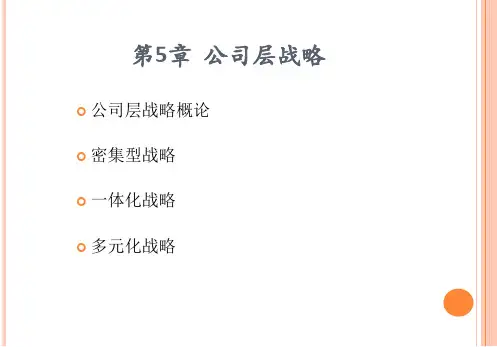
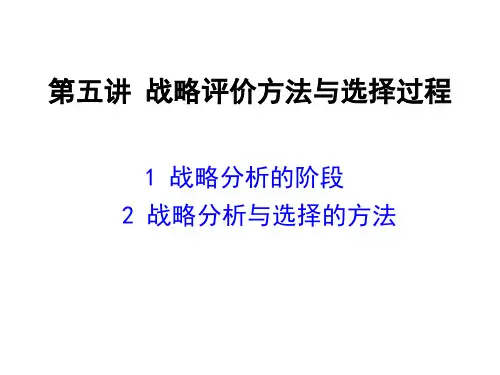
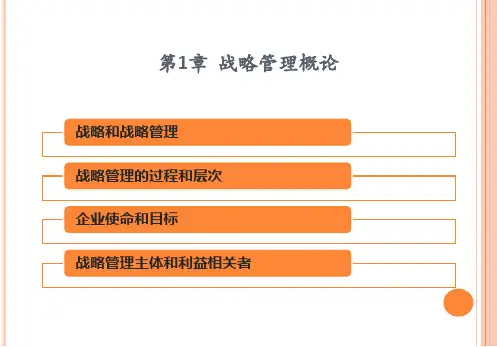

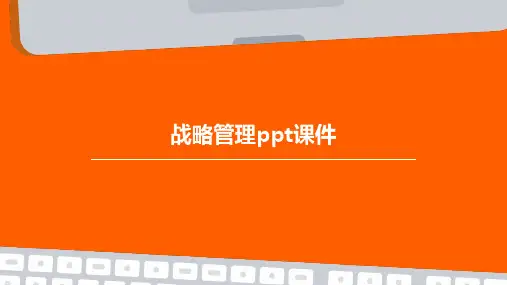
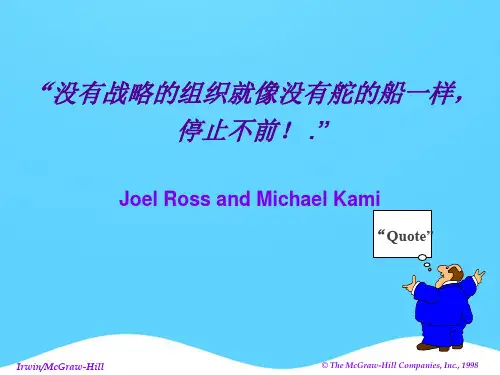
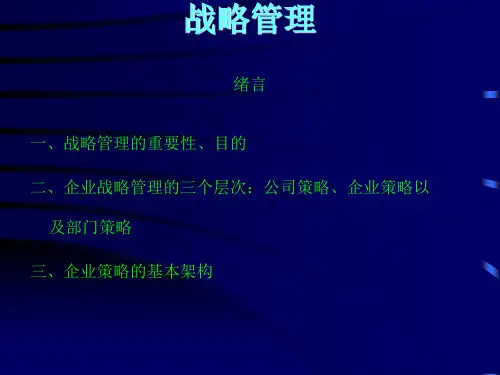

《战略管理教案》PPT课件第一章:战略管理概述1.1 战略管理的定义1.2 战略管理的重要性1.3 战略管理的过程1.4 战略管理的挑战与机遇第二章:战略环境分析2.1 宏观环境分析(PEST分析)2.2 行业环境分析(五力模型)2.3 企业内部环境分析(SWOT分析)2.4 战略环境分析的实践应用第三章:战略制定与选择3.1 战略制定的原则与步骤3.2 战略选择的方法与工具3.3 战略规划与战略执行的关系3.4 战略选择的案例分析第四章:战略实施与控制4.1 战略实施的关键要素4.2 战略控制的机制与方法4.3 战略变革管理4.4 战略实施与控制的实践案例第五章:战略管理在企业中的应用5.1 企业战略管理案例分析5.2 企业战略管理的成功因素5.3 企业战略管理的挑战与应对策略5.4 企业战略管理的发展趋势第六章:战略管理的案例研究6.1 案例研究的重要性6.2 战略管理案例研究的方法6.3 案例研究分析框架6.4 案例研究实例:某知名企业的战略管理实践第七章:战略管理的现代观点7.1 战略管理的新视角7.2 商业模式创新与战略管理7.3 战略管理中的领导力与企业文化7.4 战略管理在数字化转型中的应用第八章:战略管理的评估与反馈8.1 战略管理评估的方法8.2 战略管理评估的指标体系8.3 战略管理反馈机制的建立8.4 战略管理评估与反馈的实践案例第九章:战略管理的伦理与责任9.1 战略管理中的伦理问题9.2 企业社会责任与战略管理9.3 伦理与责任在战略决策中的作用9.4 伦理与责任导向的战略管理实践第十章:战略管理的未来发展趋势10.1 全球化背景下的战略管理10.2 战略管理在创新驱动发展中的角色10.3 战略管理在可持续发展中的挑战与机遇10.4 未来战略管理的关键议题与趋势预测重点和难点解析重点环节1:战略管理的定义与重要性重点:理解战略管理的核心概念和其在企业运营中的关键作用。
难点:区分战略管理与其他管理领域的区别,如运营管理、财务管理等。
CHAPTER 1 -- REVIEW
1. What are strategic competitiveness, strategy competitive advantage,
above-average returns, and the strategic management process?
Strategic competitiveness is achieved when a firm successfully formulates and implements a value-creating strategy.
A strategy is an integrated and coordinated set of commitments and actions designed to exploit core competencies and gain a competitive advantage.
A competitive advantage is achieved when a firm’s current and potential competitors either are not able to simultaneously formulate and implement its value-creating strategy, are unable to duplicate the benefits of the strategy, or find the strategy too costly to imitate.
Above-average returns are returns that are in excess of what an investor expects to earn from other investments with a similar level or amount of risk.
The strategic management process (see Figure 1.1) is the full set of commitments, decisions, and actions required for a firm to achieve strategic competitiveness and earn above-average returns.
2. According to the I/O model, what should a firm do to earn above-average returns?
The I/O model suggests that conditions and characteristics of the external environment (the general, industry and competitive environments) are the primary inputs to and determinants of strategies that firms should formulate and implement to earn above-average returns. Assumptions of the I/O model are that: (1) the external environment imposes pressures and constraints that determine which strategies will result in superior profitability, (2) most firms competing in an industry (or industry segment) control similar strategically-relevant resources and pursue similar strategies in light of resource similarity, (3) resources used to implement strategies are highly mobile across firms, and (4) decision makers are assumed to be rational and committed to acting in the firm’s best interests.
The I/O model thus challenges firms to seek out the industry (or industry segment) with the greatest profit potential and then learn how to use their resources to implement value-creating strategies given the structural characteristics of the industry.
3. What does the resource-based model suggest a firm should do to earn
above-average returns?
The resource-based model assumes that each firm is a collection of unique resources and capabilities that provides the basis for its strategy and is the primary source of its profitability. It also assumes that, over time, firms acquire different resources and develop unique capabilities. Thus, all firms competing within an industry (or industry segment) may not possess the same strategically relevant resources and capabilities. In addition, resources may not be highly mobile across firms.
Thus, the resource-based model challenges firms to formulate and implement strategies that allow
the firm to best exploit its core competencies—capabilities that are valuable, rare, costly to imitate, and non-substitutable— relative to opportunities in the external environment. Resources and capabilities that meet the criteria of core competencies then serve as the basis of a firm's sustainable competitive advantage, enabling it to achieve strategic competitiveness and earn above-average returns.
4. What are the elements of the strategic management process? How are they interrelated?
The parts of the strategic management process (illustrated in Figure 1-1) are strategic inputs, strategic actions and strategic outcomes. Strategic inputs are represented by the firm’s vision and mission that result from the assessment of the firm’s resources, capabilities and competencies and conditions in the external environment. These strategic inputs—vision and mission—drive the firm’s strategic actions or the formulation and implementation of strategy. The strategic outcomes of successfully formulating and implementing value-creating strategies are strategic competitiveness and above average returns. A feedback loop links strategic outcomes with strategic inputs.。